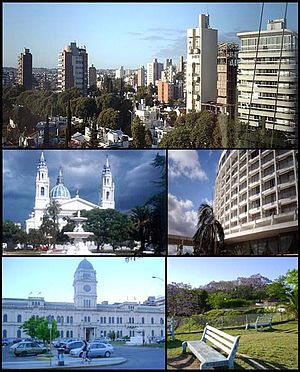 | ||
| Paraná | ||
| province | Entre Ríos | |
|---|---|---|
| Residents | 247.863 (2010) | |
| height | 66 m | |
| no tourist info on Wikidata: | ||
| location | ||
| ||
Paraná is the capital of the province Entre Ríos in the East Argentina and is located on the east bank of the Río Paranáafter which the city is named. With around 300,000 inhabitants, it is slightly smaller than the one on the west bank Santa Fewith which the city is connected by a tunnel.
Paraná, which was the capital of Argentina between 1852 and 1860, is a green and clean city with a subtropical flair, in which numerous buildings from the colonial period and in particular from the 19th century have been preserved. Nevertheless, it is still largely undiscovered as a travel destination.
background
When the city of Santa Fe was moved to its present location in 1649, some of the settlers founded a village on the east bank of the Paraná, Baxada del Paraná. The settlement grew steadily, and the year 1730, in which the first church was built, is now considered the year of foundation. At first, the new city grew only slowly.
In 1852 the place got a new boom when the constituent assembly of the emerging Argentine nation-state Paraná chose itself as its seat. This was necessary because the province Buenos Aires had resigned from the confederation in protest against the federalist spirit of this constitution. In 1853 the constitution was passed in the city and at the same time Paraná was made the capital of the country. In 1860 the two states reunited to form what is today República Argentina, and the capital was moved back to the metropolis on the Río de la Plata.
From 1870 Paraná finally became a big city when numerous immigrants from Europe settled there. As a result, a diversified industry developed, so that today Paraná is one of the economically best-placed cities in the Argentine northeast.
getting there
By plane
Paraná has its own airport (Aeropuerto General Justo José de Urquiza), but only twice a week from LADE flights Buenos Aires and Cordoba as well as to Patagonia. Usually the airport Viejo sauce used south of the neighboring city of Santa Fe, which is served more frequently, but also only a few connections (Buenos Aires, Rosario and Rafaela, with a change in Rosario too Uruguay and Cordoba as well Mar del Plata can be reached).
By train
The railway line to Paraná is closed. The opposite Santa Fe is, however, connected to the passenger network, but the route is currently being renovated due to severe flood damage and is therefore not being served.
By bus
Almost all cities in Argentina can be reached by bus from Paraná. The bus station is in the street Ramirez, Corner Echagüe.
In the street
From Buenos Aires, the most recommended option is to drive via Rosario and Santa Fe, with the Ruta Nacional 9 and the Autopista Rosario-Santa Fe are consistently expanded to the motorway.
By boat
mobility
Public transport is handled by buses.
Tourist Attractions

Churches, mosques, synagogues, temples
- cathedral, built in 1887. White neoclassical building.
- Iglesia San Miguel, built between 1822 and 1895, influenced by the neo-Gothic style
Buildings
- Colegio del Huerto, built in 1859, in neo-renaissance style. The Senate of the Argentine Confederation functioned here for a short time until Buenos Aires finally became the seat of government again in 1864.
- town hallCorner building, built in 1890, with a dominant tower clock.
- Government palace, neo-Romanesque, elongated building from 1900.
Monuments
- Monument in honor of Justo José de Urquiza. The first constitutional president of Argentina is depicted on horseback as usual. Inaugurated in 1920 and located in Parque Urquiza, it is particularly attractive because of the view from the location of the river.
Museums
- Museo de Bellas Artes Pedro E. Martínez, Art museum, built around 1900 as a colonial-style house.
Parks
- Urquiza Park, located on the Río Paraná.
various
- Túnel Subfluvial Uranga-Silvestre Begins. 2.7 km long, 1960 built tunnel under the Río Paraná that connects the long isolated cities of Paraná and Santa Fe. Guided tours are offered.
activities
In Parque Urquiza there are several bathing beaches on the Río Paraná.
shop
kitchen
Cheap
medium
Upscale
nightlife
accommodation
Cheap
medium
Upscale
Learn
Work
security
health
Practical advice
Zip code is E3100, Telephone code 0343.
trips
Between Paraná and Diamante there are several colonies of Volga Germans, some of which still speak German today. These are particularly interesting for tourists because of the Central European architecture, especially the churches. The city too Crespo (15,000 inhabitants) emerged from such a colony.
literature
Web links
- http://www.parana.gob.ar/ - Official website of Paraná

